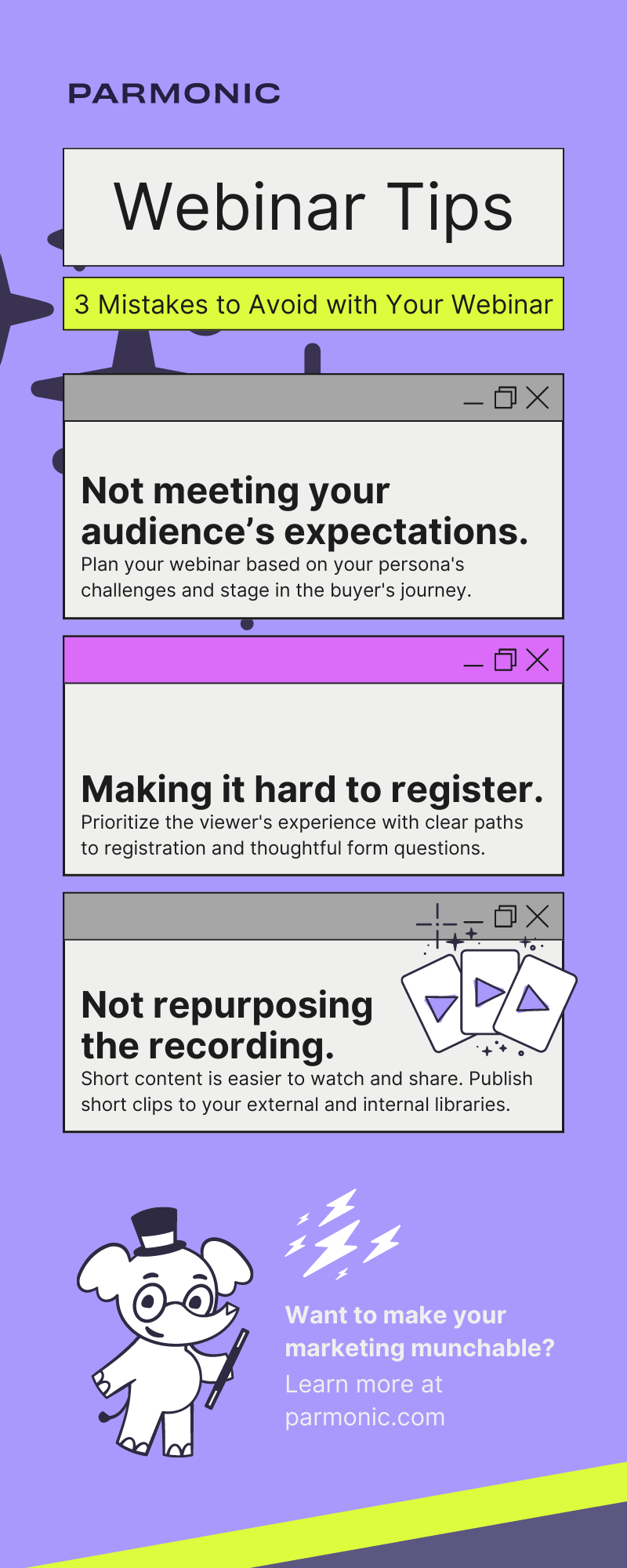3 Common Webinar Mistakes to Avoid
With webinars being used by companies of every size to drive demand gen and fuel sales pipelines, it’s critical for marketers to understand both best practices and common pitfalls before going live or hitting record. How can you plan a webinar to cut through the virtual event noise and generate interest in your buyers?
Hosting a successful online seminar is a significant investment and no one wants to have the return affected by avoidable errors. Let’s look at some of the webinar mistakes you don’t want to make while hosting your 1st or 100th webinar.
Not meeting your audience’s expectations.
The best webinars solve problems and meet audiences where they are in the buyer’s journey. A persona-based approach is particularly useful for uncovering your audience’s unique challenges and pain points.
What is keeping your buyer up at night? How can you plan a webinar that shows that you understand their problem and have the knowledge, skills, and functional ability to solve it?
In addition to your buyer’s persona, different types of webinars work better for varying levels of buyer maturity. For example, broad thought-leadership topics are more appealing for TOFU (top of the funnel) prospects who are still in the first stage of awareness. On the other hand, deep-dive product demos are effective for buyers who are further along in the journey and deciding on product features and benefits.
By understanding persona-based challenges and your buyer’s journey, you can create an authentically helpful and relevant webinar. Meeting your buyers where they are will build trust and encourage them to consider you as a potential solution to their problems.

Making it hard to register.
Can your audience access your webinar registration page with a single click? In this age of packed calendars and busy schedules, making the registration process as simple as possible is even more important. How often have you bailed out on a signup after clicking through a maze of CTAs?
Ideally, your audience should be able to click on a link (from an email, social post, etc.) and land directly on a registration page optimized to convert them. If they’re already in your database or CRM, using auto form-fill to pre-populate the form has been shown to increase registration conversions.
You’ll also need to consider how much information you must ask for on the registration form. While decreasing the number of fields on the form will increase the conversion rate, if your webinar targets the top of your funnel, those leads may not be high quality, and the lack of data could make it difficult to qualify them.
But if you’re presenting to an audience already known to your team, you can likely ask for less information from the person submitting the form without losing critical details. Prioritize your user’s experience by thinking about what you need to know, what you already know, and what you can get to know from other sources whenever you’re asking them to convert.
Not repurposing the recording.
How much content do you watch live vs. on-demand? If you’re like most people, your busy schedule probably results in limited time to check out your favorite TV series, never mind a webinar for work!
As we’ve become accustomed to accessing media on our own time, it’s more important than ever to have a strategy to maximize your webinar recording. According to ON24, 34% of webinar viewers only watched on-demand recordings only in 2020, which is expected to grow in the coming years. Not planning for on-demand service can result in missing nearly half your target audience.
To take your on-demand strategy to the next level, consider editing an hour-long recording into shorter highlights for easier sharing and watching. Since it’s been proven that humans now have an average attention span of eight seconds, marketers need to consider this, particularly in digital content marketing.
Vidyard reported in the 2021 Video in Business Benchmark Report that an average of 62% of viewers will stay engaged until the end of a video if that video is under 60 seconds in length. In contrast, if a video is over 20 minutes long, 26% of viewers keep watching until the end.
The key takeaway for marketers is understanding that shorter video content is crucial for top-funnel awareness and easy sharing. Still, it’s also essential to have some longer edits available and align more with mid-lower funnel prospects. Video AI like Parmonic makes it easy to create and distribute both.
By meeting and exceeding your audience’s expectations, making it easy to register, and repurposing the recording, you’ll be well on your way to hosting successful webinars that produce results.
To learn more about making your webinar content munchable with Parmonic, book a demo.
[Infographic] 3 Mistakes to Avoid with Your Webinar

Originally published 08/03/2021 | Updated 07/08/2022



